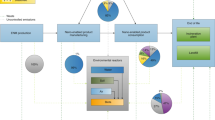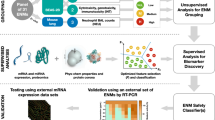Abstract
Challenges in distinguishing between natural and engineered nanomaterials (ENMs) and the lack of historical records on ENM accidents have hampered attempts to estimate the accidental release and associated environmental impacts of ENMs. Building on knowledge from the nuclear power industry, we provide an assessment of the likelihood of accidental release rates of ENMs within the next 10 and 30 years. We evaluate risk predictive methodology and compare the results with empirical evidence, which enables us to propose modelling approaches to estimate accidental release risk probabilities. Results from two independent modelling approaches based on either assigning 0.5% of reported accidents to ENM-releasing accidents (M1) or based on an evaluation of expert opinions (M2) correlate well and predict severe accidental release of 7% (M1) in the next 10 years and of 10% and 20% for M2 and M1, respectively, in the next 30 years. We discuss the relevance of these results in a regulatory context.
This is a preview of subscription content, access via your institution
Access options
Access Nature and 54 other Nature Portfolio journals
Get Nature+, our best-value online-access subscription
$29.99 / 30 days
cancel any time
Subscribe to this journal
Receive 12 print issues and online access
$259.00 per year
only $21.58 per issue
Buy this article
- Purchase on Springer Link
- Instant access to full article PDF
Prices may be subject to local taxes which are calculated during checkout




Similar content being viewed by others
Data availability
The datasets generated and/or analysed during the current study are available from the corresponding author on reasonable request. Source data are provided with this paper.
Code availability
R scripts are available from the corresponding author on reasonable request.
References
Hochella, M. F. et al. Natural, incidental, and engineered nanomaterials and their impacts on the earth system. Science 363, eaau8299 (2019).
European Commission. Commission Recommendation of 18 October 2011 on the Definition of Nanomaterial. Official Journal of the European Union L275, 38–40 (2011).
Kaegi, R. et al. Synthetic TiO2 nanoparticle emission from exterior facades into the aquatic environment. Environ. Pollut. 156, 233–239 (2008).
Praetorius, A. et al. Single-particle multi-element fingerprinting (SpMEF) using inductively-coupled plasma time-of-flight mass spectrometry (ICP-TOFMS) to identify engineered nanoparticles against the elevated natural background in soils. Environ. Sci. Nano 4, 307–314 (2017).
Flores, K. et al. Environmental applications and recent innovations in single particle inductively coupled plasma mass spectrometry (SP-ICP-MS). Appl. Spectrosc. Rev. 56, 1–26 (2021).
Mehrabi, K., Gunther, D. & Gundlach-Graham, A. Single-particle ICP-TOFMS with online microdroplet calibration for the simultaneous quantification of diverse nanoparticles in complex matrices. Environ. Sci. Nano 6, 3349–3358 (2019).
Mehrabi, K., Kaegi, R., Gunther, D. & Gundlach-Graham, A. Emerging investigator series: automated single-nanoparticle quantification and classification: a holistic study of particles into and out of wastewater treatment plants in Switzerland. Environ. Sci. Nano 8, 1211–1225 (2021).
Loosli, F. et al. Sewage spills are a major source of titanium dioxide engineered (nano)-particle release into the environment. Environ. Sci. Nano 6, 763–777 (2019).
Wang, J., Nabi, M. M., Erfani, M., Goharian, E. & Baalousha, M. Identification and quantification of anthropogenic nanomaterials in urban rain and runoff using single particle-inductively coupled plasma-time of flight-mass spectrometry. Environ. Sci. Nano 9, 714–729 (2022).
von der Kammer, F. et al. Analysis of engineered nanomaterials in complex matrices (environment and biota): general considerations and conceptual case studies. Environ. Toxicol. Chem. 31, 32–49 (2012).
Wigger, H., Kägi, R., Wiesner, M. & Nowack, B. Exposure and possible risks of engineered nanomaterials in the environment—current knowledge and directions for the future. Rev. Geophys. 58, e2020RG000710 (2020).
Bland, G. D., Battifarano, M., Pradas del Real, A. E., Sarret, G. & Lowry, G. V. Distinguishing engineered TiO2 nanomaterials from natural Ti nanomaterials in soil using SpICP-TOFMS and machine learning. Environ. Sci. Technol. 56, 2990–3001 (2022).
Wiesner, M. R., Lowry, G. V., Alvarez, P., Dionysiou, D. & Biswas, P. Assessing the risks of manufactured nanomaterials. Environ. Sci. Technol. 40, 4336–4345 (2006).
Gottschalk, F., Sonderer, T., Scholz, R. W. & Nowack, B. Modeled environmental concentrations of engineered nanomaterials (TiO2, ZnO, Ag, CNT, fullerenes) for different regions. Environ. Sci. Technol. 43, 9216–9222 (2009).
Keller, A. A., McFerran, S., Lazareva, A. & Suh, S. Global life cycle releases of engineered nanomaterials. J. Nanopart. Res. 15, 1692 (2013).
Song, R., Qin, Y., Suh, S. & Keller, A. A. Dynamic model for the stocks and release flows of engineered nanomaterials. Environ. Sci. Technol. 51, 12424–12433 (2017).
Sun, T. Y. et al. Envisioning nano release dynamics in a changing world: using dynamic probabilistic modeling to assess future environmental emissions of engineered nanomaterials. Environ. Sci. Technol. 51, 2854–2863 (2017).
Giese, B. et al. Risks, release and concentrations of engineered nanomaterial in the environment. Sci. Rep. 8, 1565 (2018).
Sun, T. Y., Bornhöft, N. A., Hungerbühler, K. & Nowack, B. Dynamic probabilistic modeling of environmental emissions of engineered nanomaterials. Environ. Sci. Technol. 50, 4701–4711 (2016).
Zheng, Y., Mutzner, L., Ort, C., Kaegi, R. & Gottschalk, F. Modelling engineered nanomaterials in wet-weather discharges. NanoImpact 16, 100188 (2019).
European Research Project: GUIDEnano. https://www.guidenano.eu/ (accessed 18 October 2022).
European Research Project (H2020): GRACIOUS. https://cordis.europa.eu/project/id/760840/de (accessed 18 October 2022).
European Research Project (8FP7): ENPRA. https://cordis.europa.eu/project/id/228789/de (accessed 18 October 2022).
European Research Project (H2020): RiskGONE. https://riskgone.wp.nilu.no/ (accessed 19 December 2022).
Isigonis, P. et al. Risk governance of nanomaterials: review of criteria and tools for risk communication, evaluation, and mitigation. Nanomaterials (Basel) 9, 696 (2019).
Read, S. A. K., Kass, G. S., Sutcliffe, H. R. & Hankin, S. M. Foresight study on the risk governance of new technologies: the case of nanotechnology. Risk Anal. 36, 1006–1024 (2016).
Walser, T. et al. Exposure to engineered nanoparticles: model and measurements for accident situations in laboratories. Sci. Total Environ. 420, 119–126 (2012).
Nowack, B., Mueller, N. C., Krug, H. F. & Wick, P. How to consider engineered nanomaterials in major accident regulations. Environ. Sci. Eur. 26, 2 (2014).
Kim, K. H., Kim, J. B., Ji, J. H., Lee, S. B. & Bae, G. N. Nanoparticle formation in a chemical storage room as a new incidental nanoaerosol source at a nanomaterial workplace. J. Hazard. Mater. 298, 36–45 (2015).
Pilou, M. et al. Modeling of occupational exposure to accidentally released manufactured nanomaterials in a production facility and calculation of internal doses by inhalation. Int. J. Occup. Environ. Health 22, 249–258 (2016).
Delvosalle, C., Fiévez, C. & Pipart, A. ARAMIS project: reference accident scenarios definition in Seveso establishment. J. Risk Res. 9, 583–600 (2006).
Debray, B. et al. in Probabilistic Safety Assessment and Management (eds Spitzer, C. et al.) 358–363 (Springer, 2004); https://doi.org/10.1007/978-0-85729-410-4_58
Tixier, J., Dusserre, G., Salvi, O. & Gaston, D. Review of 62 risk analysis methodologies of industrial plants. J. Loss Prev. Process Ind. 15, 291–303 (2002).
Khan, F., Rathnayaka, S. & Ahmed, S. Methods and models in process safety and risk management: past, present and future. Process Saf. Environ. Prot. 98, 116–147 (2015).
Bottomley, P. D. W. et al. Severe accident research at the Transuranium Institute Karlsruhe: a review of past experience and its application to future challenges. Ann. Nucl. Energy 65, 345–356 (2014).
ARIA. La référence du retour d’expérience sur accidents technologiques. https://www.aria.developpement-durable.gouv.fr/ (accessed 18 October 2022).
Debray, B., Lacome, J.-M., Vignes, A., Gottschalk, F. Catalogue of Potential Accidental Releases and Accidental Release Model NanoFASE Project Deliverable D4.4 (NanoFASE, 2019); http://nanofase.eu/documents/reports
Safety of Nuclear Power Reactors (Light Water-Cooled) and Related Facilities WASH-1250 (US Atomic Energy Commission, 1973).
Ha-Duong, M. & Journé, V. Calculating nuclear accident probabilities from empirical frequencies. Environ. Syst. Decis. 34, 249–258 (2014).
Hendren, C. O. et al. Bridging nanoEHS research efforts. NanoEHS Scrimmage. US–EU.org (2016); https://us-eu.org/wp-content/uploads/2016/06/Hendren_Scrimmage_Intro_V3.pdf
Maynard, A. D. & Aitken, R. J. ‘Safe handling of nanotechnology’ ten years on. Nat. Nanotech 11, 998–1000 (2016).
Syberg, K. & Hansen, S. F. Environmental risk assessment of chemicals and nanomaterials—the best foundation for regulatory decision-making? Sci. Total Environ. 541, 784–794 (2016).
Krug, H. F. Nanosafety research—are we on the right track? Angew. Chem. Int. Ed. 53, 12304–12319 (2014).
Déclaration des substances à l'état nanoparticulaire. R-Nano.fr https://www.r-nano.fr/ (accessed 18 October 2022).
Risks. Lloyd’s Emerging Risks Team Report (Lloyd’s, 2007).
R: A Language and Environment for Statistical Computing (R Core Team, 2018).
Acknowledgements
We thank B. Giese, N. Müllner and S. Sholly for their help in conceptualizing the work and literature review during a workshop in Vienna at the beginning of the project, and B. Nowack and J. Kuenen for their review of initial versions of this study. C.O.H. acknowledges support by the National Science Foundation (NSF) and the Environmental Protection Agency (EPA) under NSF Cooperative Agreement EF-0830093 and DBI-1266252, Center for the Environmental Implications of NanoTechnology (CEINT), and the collaborative networks enabled by the US–EU NanoEHS Communities of Research as supported jointly by the US National Nanotechnology Coordination Office and the European Commission. We thank all anonymous experts at ETH, EAWAG, Agroscope, Uni Vienna, Helmholtz-Zentrum für Umweltforschung and the Building Department, Canton of Zurich for their evaluation of raw data. This research was funded by the European Union’s Horizon 2020 research and innovation programme and was delivered in the project NanoFASE (Nanomaterial Fate and Speciation in the Environment) under grant agreement number 646002. S.H., S.L. and C.S. were also supported by the UK Natural Environment Research Council (NERC) and the UK Centre for Ecology and Hydrology Institute Funding award.
Author information
Authors and Affiliations
Contributions
F.G. and R.K conceived and designed the study. F.K and B.P. provided insights from industry. F.G., B.D., J.-M.L., A.V., V.P.P., S.L. and S.H. developed and commented on the modelling approaches. S.V.-C., C.O.H. and C.S. provided context for future challenges for future accident probability estimations. F.G. and R.K. wrote and edited the paper, with contributions and support from all coauthors.
Corresponding author
Ethics declarations
Competing interests
The authors declare no competing interests.
Peer review
Peer review information
Nature Nanotechnology thanks Mohammed Baalousha and Khara Grieger for their contribution to the peer review of this work
Additional information
Publisher’s note Springer Nature remains neutral with regard to jurisdictional claims in published maps and institutional affiliations.
Supplementary information
Supplementary Information
Supplementary sections 1–5, Figs. 1–3, Tables 1–5 and references.
Source data
Source Data Fig. 3
Source data for Figure 3.
Source Data Fig. 4
Source data for Figure 4.
Rights and permissions
Springer Nature or its licensor (e.g. a society or other partner) holds exclusive rights to this article under a publishing agreement with the author(s) or other rightsholder(s); author self-archiving of the accepted manuscript version of this article is solely governed by the terms of such publishing agreement and applicable law.
About this article
Cite this article
Gottschalk, F., Debray, B., Klaessig, F. et al. Predicting accidental release of engineered nanomaterials to the environment. Nat. Nanotechnol. 18, 412–418 (2023). https://doi.org/10.1038/s41565-022-01290-2
Received:
Accepted:
Published:
Issue Date:
DOI: https://doi.org/10.1038/s41565-022-01290-2
This article is cited by
-
The comparative effects of visible light and UV-A radiation on the combined toxicity of P25 TiO2 nanoparticles and polystyrene microplastics on Chlorella sp.
Environmental Science and Pollution Research (2023)



